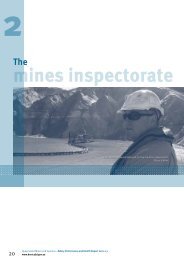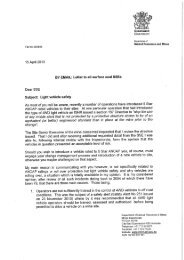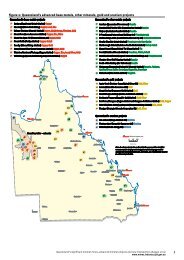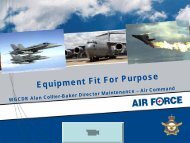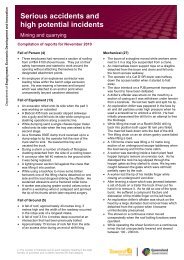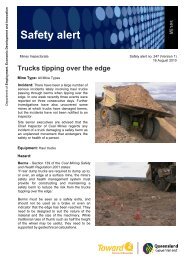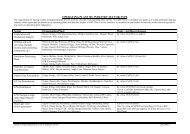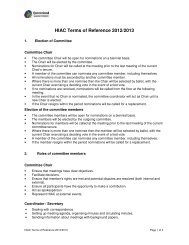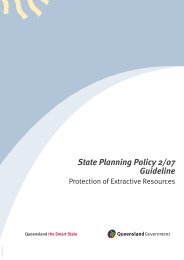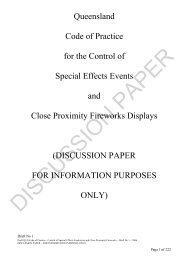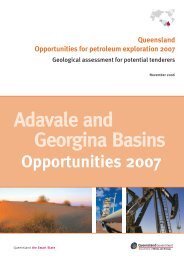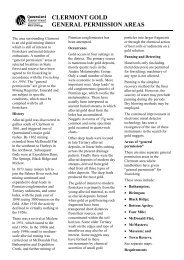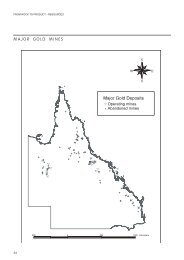(Introduction, results, summary) (PDF, 69 kB) - Queensland Mining ...
(Introduction, results, summary) (PDF, 69 kB) - Queensland Mining ...
(Introduction, results, summary) (PDF, 69 kB) - Queensland Mining ...
You also want an ePaper? Increase the reach of your titles
YUMPU automatically turns print PDFs into web optimized ePapers that Google loves.
North <strong>Queensland</strong> Tyre Fitters<br />
Workshop Meeting<br />
Minutes and<br />
Recommendations Report<br />
Location: RSL Townsville<br />
Date: 2 September 2004<br />
Participants<br />
Adrian Angus Wheels and Rims Manager<br />
Anthony Cole CQML Mtce Supervisor<br />
Anthony Martin PCPL Rio Tinto Tyre Fitter/ Supervisor<br />
Bill Whalen Theiss Mtce Superintendent<br />
Chris Little CQML Supervisor<br />
Darran Lysaght Klinge Tyre Fitter/ Supervisor<br />
Daryl McLennan Xstrata Tyre Fitter/ Supervisor<br />
David McAlpin HMP Construction Mtce Supervisor<br />
David Reece NRM Inspector of Mines<br />
Denis Clark Bridgestone Manager<br />
Edie Hartmann Klinge Support Officer<br />
Graham Robinson Goodyear Trainer<br />
Grant McLennan Giant Tyre Vulcanisers Owner<br />
Greg Scalan Zinifex Mine S&H Manager<br />
Ian Neill Roche <strong>Mining</strong> General Manager<br />
Joe Ahern BMA Coal Tyre Fitter<br />
John Smith NRM Inspector of Mines<br />
Karl Krajewski Rimex<br />
Kevin Cockburn Roche <strong>Mining</strong> Tyre Manager<br />
Lance Schmidt Foxleigh <strong>Mining</strong> Mtce Supervisor<br />
Loch Bennett Xstrata Ernest Henry Tyre Fitter/ Supervisor<br />
Peter Power NRM Inspector of Mines<br />
Phil Harradence Tyre Fitter<br />
Rob Armstrong Bridgestone Manager<br />
Rob O'Sullivan NRM Inspector of Mines<br />
Ron McConchie BMA Coal S&H Manager<br />
Russel Scaroni Theiss Mtce Superintendent<br />
Scott Laing Roche <strong>Mining</strong> Tyre Fitter/ Supervisor<br />
Tilman Rasche Klinge Manager<br />
Tyre Fitters Workshop Townsville 2 Sep 2004: Minutes and Report. Author: Peter Power Page 1
Table of Contents<br />
1.0 <strong>Introduction</strong> .........................................................................................................3<br />
2.0 Objective Outcomes of the Workshop..........................................................3<br />
2.1 Short Term Goals.................................................................................................3<br />
2.2 Longer Term Goals..............................................................................................3<br />
5.0 Specific areas of discussion included: ..........................................................3<br />
6.0 Results of Workshop .........................................................................................4<br />
6.1 Presentations ........................................................................................................4<br />
6.1.1 Bridgestone Presentation ..............................................................................4<br />
6.1.2 NRM Presentation on Fatal Accidents..........................................................5<br />
6.1.3 Roche <strong>Mining</strong> Presentation on Century Mine Operation .............................5<br />
6.1.4 Giant Tyre Vulcanisers Presentation ............................................................5<br />
6.2 General Discussion ..............................................................................................5<br />
6.3 Issues Identified and Proffered Throughout the Workshop.................................5<br />
6.4 Summary of Workshop Identified Issues.............................................................5<br />
6.4.1 Tyre handling equipment. .............................................................................5<br />
6.4.2 The practicality of some of the requirements of AS4457.............................6<br />
6.4.3 Wheel and Rim serviceability standards, Appendix B AS4457 Classification<br />
of Defects. ..............................................................................................................7<br />
6.4.4 Training of Tyre Serviceman........................................................................7<br />
7.0 Other Issues Raised ...........................................................................................7<br />
7.1 Workshop Issues Highlighted..............................................................................7<br />
7.2 Studs, Torque and Tension ..................................................................................9<br />
8.0 Summary of Recommended Comments to AS4457 Committee............9<br />
9.0 Summary ............................................................................................................11<br />
Appendix 1: NRM Presentation...........................................................................12<br />
Appendix 2: Bridgestone Presentation.................................................................13<br />
Appendix 3 Giant Tyre Vulcanisers Draft Standard for Tyre Repairs ................30<br />
Appendix 4: Tyre Workshop Meeting Items/Issues ............................................32<br />
Appendix 5 Suitability of Wheeled Loaders........................................................39<br />
Appendix 6: Stud and wheel nut information......................................................41<br />
Appendix 7: Fusible Links...................................................................................42<br />
Tyre Fitters Workshop Townsville 2 Sep 2004: Minutes and Report. Author: Peter Power Page 2
1.0 <strong>Introduction</strong><br />
A one-day Tyre Fitter’s workshop was held at the Townsville RSL on 2 September<br />
2004. Participants were invited from the majority of mining operations in <strong>Queensland</strong><br />
where 57 and 63-inch rims are in use. The make up of the participants included tyre<br />
fitters (serviceman) and their manager/supervisor from coal and metalliferous mining<br />
sites, tyre manufacturers representatives from Bridgestone and Goodyear, rim<br />
repairer/manufacturers from Rimex and Wheels and Rim, a Mine Operator and<br />
representatives from the Department of Natural Resources and Mines.<br />
2.0 Objective Outcomes of the Workshop<br />
2.1 Short Term Goals<br />
1) This workshop was held to identify any current and emerging issues with<br />
regards to tyre fitting of very large heavy earthmover tyres by involving and<br />
consulting with experienced personnel from the mining industry.<br />
2) If time permitted to consider and discuss solutions.<br />
2.2 Longer Term Goals<br />
1) Distribute minutes of workshop to all participants for comment.<br />
2) To distribute ratified minutes to all of the mining industry and other<br />
pertinent bodies within 5 weeks of issuing first draft.<br />
3) Tyre fitters and managers to conduct risk assessments where appropriate on<br />
any identified issues, not already effectively dealt with, upon returning to<br />
their sites and receiving this information.<br />
4) NRM to approach manufacturers and industry with identified issues and<br />
where required seek engineering solutions.<br />
5) To provide feedback where appropriate to the Australian Standards<br />
Committee with recommendations for changes to AS4457.<br />
Prior to the workshop each tyre fitter and manager was requested to think about the<br />
following discussions points. These points were discussed at length in the workshop.<br />
Time was made available for each site and or individual to present any information<br />
regarding the discussion points or any other issues that they believed to be relevant.<br />
5.0 Specific areas of discussion included:<br />
1) Tyre inflation pressure during removal and fitting. What do site procedures<br />
recommend and are they practical.<br />
Tyre Fitters Workshop Townsville 2 Sep 2004: Minutes and Report. Author: Peter Power Page 3
2) Tyre manipulation equipment problems. Current equipment has difficulties<br />
in manipulating large tyres at low pressures.<br />
3) Removal of tapered mounted rims from large haul fleet equipment. What are<br />
the difficulties for tyre fitters?<br />
4) 5 and 7 piece rims, are there any problems<br />
5) Any other issues identified by tyre fitters<br />
6.0 Results of Workshop<br />
6.1 Presentations<br />
6.1.1 Bridgestone Presentation<br />
A presentation was given from Bridgestone on tyres and rims with clear<br />
definition of a tyre explosion and a tyre burst condition. Presentation attached.<br />
Some of the key points included:<br />
1) Tyres can explode with as little as 5% oxygen.<br />
2) A 53.80 R63 tyre has 51,135 litres of air at normal cold operating pressure.<br />
3) Tyre rubber ignition temperature approx 400°.<br />
4) Tyre bonding breaks down at 105°.<br />
5) Valve caps prevent leaks.<br />
6) Improbable an external fire will cause an internal fire due to rubber being a<br />
very good insulator.<br />
7) Vehicles should be isolated for 12 hours after contact with power lines.<br />
8) Tyre explosions result in many times the force of normal inflation<br />
pressure. Tyre carcass FOS 7. A new tyre will explode if pressure is above<br />
50 atmospheres (700 psi).<br />
9) Tyres should not be reinflated if run at below 60% of normal inflation<br />
pressure.<br />
10) During a tyre fire a fusible link in the valve line ensures the tyre deflates.<br />
There are purpose built fusible links available see Appendix 7.<br />
Tyre Fitters Workshop Townsville 2 Sep 2004: Minutes and Report. Author: Peter Power Page 4
6.1.2 NRM Presentation on Fatal Accidents<br />
A presentation (attached) was given by the NRM on recent fatal incidents in the<br />
USA, Canada and Australia involving tyre fitters. Two common causes were<br />
applying heat to the rim of an inflated tyre and being crushed by falling tyres.<br />
6.1.3 Roche <strong>Mining</strong> Presentation on Century Mine Operation<br />
Roche <strong>Mining</strong> gave a presentation on the Century operations and some of the<br />
general issues regarding tyre fitting. Some of the identified issues included the<br />
integrity of the tyre and rim assembly if handled below 15 psi and valve<br />
damage to 630Es.<br />
6.1.4 Giant Tyre Vulcanisers Presentation<br />
Giant Tyre Vulcanisers gave a presentation on tyre repairing. They suggested<br />
that a standard should be adopted universally for identifying tyre repair. They<br />
produced a draft that identifies three levels of damage markings, which will<br />
make it easy for personnel to identify the extent of belt/tyre damage that has<br />
been effected in a repair.<br />
6.2 General Discussion<br />
Following this NRM facilitated a session discussing the significant issues regarding<br />
tyre fitting, rim maintenance and servicing. After lunch the group was divided into<br />
two syndicates. Tyre servicemen were taken to a separate room and the remainder of<br />
the group stayed behind in the main auditorium. The two groups were recombined<br />
later in the day to wrap up the workshop.<br />
6.3 Issues Identified and Proffered Throughout the Workshop<br />
There were a large number of issues identified and discussed during the workshop.<br />
The attached spreadsheet summarises all of those issues. There are four distinctive<br />
areas, in which the majority of the issues can be captured, with some overlap. These<br />
include:<br />
1) Tyre handling equipment.<br />
2) The practicality of some of the requirements of AS4457.<br />
3) Wheel and Rim serviceability standards.<br />
4) Training competencies for tyre servicemen.<br />
6.4 Summary of Workshop Identified Issues<br />
6.4.1 Tyre handling equipment.<br />
1) The large tyres, at 40.00 and larger, cannot be manipulated/handled by the<br />
equipment currently used on mine sites without having a pressure significantly<br />
higher than stipulated by AS4457 and without greatly increasing the potential<br />
for the tyre to fall from the grippers, particularly when wet, and to cause<br />
structural damage to the tyre belts from over compressing. The word handling<br />
Tyre Fitters Workshop Townsville 2 Sep 2004: Minutes and Report. Author: Peter Power Page 5
and manipulating refer to the time the tyre or tyre and rim assembly is being<br />
handled when not bolted to the truck or in storage etc. The equipment used to<br />
grip the tyres has grown up from the days when tyres were not as large as they<br />
are today.<br />
2) Visibility is better on fork lift style tyre handling equipment. Forklift may be a<br />
better option that FEL and it potentially removes a person from between<br />
vehicle and tyre.<br />
I have been provided with information from Keith Larsen, Manager Engineering<br />
Services, Hastings Deering, regarding the suitability of wheeled loaders for tyre<br />
handling activities. I have included his comments in Appendix 5. In <strong>summary</strong> he says<br />
that such equipment is not specifically designed for precision positioning particularly<br />
for Z bar and parallelogram type linkages. This is because the tilt cylinder and lift<br />
cylinder linkages are mechanically interconnected and the lift and tilt cylinder forces<br />
react against each other, largely independent of load but rather dependant on lift arm<br />
position and bucket orientation. In these cases larger tilt cylinder forces against their<br />
stops can induce reactive pressures in the lift cylinders above their relief. This may<br />
induce the lift arms to lower momentarily and have uncontrolled movement. Sites that<br />
use this style of equipment need to ensure that the risk from using wheeled loaders<br />
with such mechanical linkages during tyre fitting activities is acceptable.<br />
6.4.2 The practicality of some of the requirements of AS4457<br />
1) 3.2.3 Maximum pressure of 35kPa for tapered mounted rims. There is no<br />
one particular pressure that will suffice all situations. There is a variation<br />
between mine sites using identical tyre sizes in terms of the pressures<br />
identified in Standard Operating Procedures for handling them. Tyres should<br />
not be handled with pressure unless the integrity of the components is<br />
established. As stated above the large tyres, 40.00R57 and larger, cannot be<br />
managed well at 35kpa. (My comment: Ensure that your site has well developed<br />
procedures for these tasks built up on risk assessment process.) It is anticipated that<br />
the issues of tyre pressure will be engineered out through better-designed tyre<br />
handling equipment however I the interim the topic of maximum pressures is<br />
presently an issue.<br />
2) A9.1 A tyre which has been run flat or in a severely under inflated<br />
condition should not be fitted or inflated until the integrity of the tyre has<br />
been established. The integrity of the rim components must be established<br />
also. This comment needs to be included in A9.1. Tyres run at under 60% of<br />
normal inflation pressure should fall into this category also.<br />
3) A9.2 (b) Connect an air line with a clip on chuck and preferably inline<br />
pressure gauge to the valve assembly. The airline should also be long<br />
enough to allow the tyre servicemen to stand away from any exploding<br />
components. There should be a ‘T’ piece in the line, at a remote location,<br />
Tyre Fitters Workshop Townsville 2 Sep 2004: Minutes and Report. Author: Peter Power Page 6
that allows the servicemen to immediately drop the air from the tyre should<br />
something go wrong during the inflation. This could be a recommendation<br />
for inclusion in A9.2 of AS4457.<br />
4) Consideration to be given to suggestion by Giant Tyre Vulcanisers to<br />
include a standard for tyre repair identification in AS4457. Tyre repair<br />
identification process should be standardised and communicated for<br />
transportability of competence. Development of standard and definitions of<br />
repairs to be standardised. See attached draft from Giant Tyre Vulcanisers.<br />
6.4.3 Wheel and Rim serviceability standards, Appendix B AS4457 Classification of<br />
Defects.<br />
AS 4457 calls for identification/inspection of wheels and rims and gives<br />
instructions regarding repairs required but does not give serviceability limits for<br />
components. A general serviceability limit for wheels and rims are required.<br />
This could include hours of operation before removal for testing and a standard<br />
to compare against for when is a rim non serviceable. When should a rim be<br />
designated as unserviceable etc? How many times should a rim be serviced<br />
before being replaced? How much material can be machined off the back<br />
section of the rim? See point 5 under section 8.0.<br />
6.4.4 Training of Tyre Serviceman.<br />
A lot of discussion was generated by the Tyre Servicemen regarding the<br />
specialised era that tyre fitting training is now entering. It was also discussed by<br />
the main group. In <strong>summary</strong> tyres are getting larger, rims are becoming more<br />
diversified and the task of tyre fitting is becoming further specialised. It is<br />
suggested that the training competency 1032 and 1031 require review.<br />
The intention is to now pursue these topics to a satisfactory resolution and to produce<br />
a safety bulletin on tyre and rim safety that includes clear reference to the issues<br />
raised at the workshop, good industry practice regarding tyres and rims and reference<br />
to legislation and other relevant documents.<br />
7.0 Other Issues Raised<br />
7.1 Workshop Issues Highlighted<br />
There were other observations and issues raised during the workshop some of which<br />
have been discussed above. The remainder of the issues are included below and as<br />
mentioned are included in Appendix 1. Participants are invited to offer/nominate any<br />
specific recommendations or comments regarding these issues. All of the comments<br />
collected from the workshop will become part of the information included in the<br />
proposed safety bulletin.<br />
Tyre Fitters Workshop Townsville 2 Sep 2004: Minutes and Report. Author: Peter Power Page 7
Other observations made by the workshop included:<br />
1) Most cracking occurring under lock ring and back taper area. Cracks in the<br />
pressure section may not become an issue until the cleats are released.<br />
2) Plastic deformation occurring on rims after certain operating and pressure<br />
conditions.<br />
3) Manufacturers are responsive to changes/developments; this needs to<br />
continue.<br />
4) There is concern with equipment manufacturers not keeping pace with<br />
wheel/rim/tyre improvements, particularly with local improvements. The<br />
main concern here is with 63-inch rims. There are currently only three<br />
manufacturers, (Rimex,Topy and Titan), with 2 of those supplying around<br />
95% of the market (Rimex and Topy). The forces on this wheel are such that<br />
the standard HDT designs are non-performing, even where original<br />
equipment manufacturers have dramatically increased the quality of their<br />
wheels.<br />
5) Retaining force is reduced for every retorque that is carried out. Wheel<br />
spins, studs fatigue. Stud replacement. This is potentially a significant issue.<br />
Major improvement in clocking vs. sequential torqueing. See 7.2 below.<br />
6) Stamping of all components. Some sites package all of the components after<br />
repair to avoid mismatch.<br />
7) Lock ring tab / retainer hoop “sure lock” found on some rims was designed<br />
to tyre inflation if lock ring was crocked. It may inadvertently prevent lock<br />
ring from physically coming out of gutter unless tyre is completely deflated<br />
and the bead seat band depressed. Needs to be followed up.<br />
8) There are also lock ring locks and clamps, which will increase the integrity<br />
and security of the seating of the lock ring.<br />
9) Concern was raised over Tyre Servicemen working alone on night shift.<br />
Night shift is usually a period of higher fatigue and Tyre fitting is a critical<br />
task containing a high amount of potential energy, not the same as operating<br />
a laptop computer.<br />
10) Can be difficultly getting an 830E pos 4 or 5 rim to free up some times.<br />
Nowhere to effectively jack rim between chassis and rim base. Most jacking<br />
occurs on the back flange.<br />
11) There can be seating problems with Dresser phase 2. 100% pressure often<br />
required seating tyre on bead seat.<br />
Tyre Fitters Workshop Townsville 2 Sep 2004: Minutes and Report. Author: Peter Power Page 8
7.2 Studs, Torque and Tension<br />
RIMEX has provided information in relation to the relationship between torque,<br />
friction and tension achieved on wheel studs. The information is included in<br />
Appendix 6. In <strong>summary</strong> torquing a wheel nut to a specified tension does not<br />
necessarily mean that the desired tension will be achieved in the wheel stud,<br />
particularly where dirt, rust and other impediments are involved in increasing the<br />
friction resisting torque. In one test, with a new wheel nut and stud, the desired<br />
tension was achieved through the first torque but after releasing the nut and<br />
retorquing the nut to the same torque the tension was reduced by approximately<br />
15% due to galling on the wheel nut from the first torque.<br />
Other points raised include an indication that tapered rims may require more<br />
retorques than a knave plated wheel. Sites should closely review their retorquing<br />
procedures and determine that the required tension in the wheel stud is being<br />
maintained and careful consideration to be given to a stud change-out policy.<br />
8.0 Summary of Recommended Comments to AS4457 Committee<br />
These comments will be recommended to the AS4457 committee for review.<br />
1) The maximum pressure of 35kPa for tapered mounted rims is not practical<br />
for very large earthmover tyres. There is no one particular pressure that will<br />
suffice all situations. There is a variation between mine sites using identical<br />
tyre sizes in terms of the pressures identified in Standard Operating<br />
Procedures for handling them. Tyres should not be handled with pressure<br />
unless the integrity of the components is established. As stated above the<br />
large tyres, 40.00R57 and larger, cannot be managed well at 35kpa. The<br />
larger 55.80 R63 tyres may need up to 200kPa inflation pressure to be<br />
managed by the tyre manipulator. These problems are exacerbated in wet<br />
weather.<br />
2) During reinflation of a tyre the airline should also be long enough to allow<br />
the tyre servicemen to stand away from any exploding components. There<br />
should be a ‘T’ piece in the line, at a remote location, that allows the<br />
servicemen to immediately drop the air from the tyre should something go<br />
wrong during the inflation. A fusible link in the valve line in the event of a<br />
tyre fire adds another level of control.<br />
3) A tyre which has been run flat or in a severely under inflated condition<br />
should not be fitted or inflated until the integrity of the tyre and the integrity<br />
of the rim components has been established. Participants in the workshop<br />
said that if the inflation pressure had dropped to or below a certain pressure<br />
during operation then the tyre should be removed for inspection and not<br />
Tyre Fitters Workshop Townsville 2 Sep 2004: Minutes and Report. Author: Peter Power Page 9
einflated in situ. The ranges of pressure suggested for doing this was from<br />
80% to 60%.<br />
4) A repair standard that allows quick and easy identification of the extent of<br />
the repair made to a tyre from visual observation of the tyre when in position<br />
on truck, loader etc is recommended. Consideration to be given to<br />
suggestion by Giant Tyre Vulcanisers draft standard to include as a standard<br />
for tyre repair identification in AS4457.<br />
5) AS 4457 calls for identification/inspection of wheels and rims and gives<br />
instructions regarding repairs required but does not give serviceability limits<br />
for components. A general serviceability limit for wheels and rims is<br />
required. This includes hours of operation before removal for testing and a<br />
standard to compare against for when is a rim non serviceable. When should<br />
a rim be designated as unserviceable etc? How many times should a rim be<br />
serviced before being replaced? How much material can be machined off the<br />
back section of the rim. Wheel and rim manufacturers to assist in the<br />
provision of information for AS4457 committee. RIMEX has provided the<br />
following comments with respect to this point.<br />
i. General Serviceability Limits: Hours of Operation<br />
Currently the industry standard is around 15000hrs for all rims and has<br />
worked thus far. Some sites have different hours for different<br />
machines. RIMEX are currently running a program in <strong>Queensland</strong> and<br />
NSW where snapshots are taken. This involves sending in batches of<br />
rims at increasing hours to find out at what hourly service interval<br />
problems begin to arise. Once problems start to surface at a certain<br />
service interval RIMEX will reduce the hourly service interval by 10%<br />
and designate that interval as the testing point. Currently on 930E<br />
TSR’s (63”) RIMEX have increased the hours of testing to 20000hrs.<br />
This is an ongoing program.<br />
ii. When should a rim be designated as unserviceable etc<br />
RIMEX have suggested that an objective measure maybe to check the<br />
the pitting on centre bands and sections. The Australian Standard for<br />
pressure vessels identifies a maximum of 15% of depth of parent<br />
metal. RIMEX have seen pitting over 20% and fail these rims, even if<br />
test shows no cracking in sections.<br />
iii. How many times should a rim be serviced before being<br />
replaced?<br />
RIMEX suggest that after one back section and or one gutter section is<br />
replaced. The amount a wheel diameter shrinks when cut or welded is<br />
surprisingly large and leads to a fair amount of heat stress-weakening<br />
the rim.<br />
Tyre Fitters Workshop Townsville 2 Sep 2004: Minutes and Report. Author: Peter Power Page 10
iv. How much material can be machined off the back section of<br />
the rim<br />
This section of the rim is not intended to be machined save only for<br />
skimming raised edges from metal flow. RIMEX state why make a<br />
heavier wheel to counteract failures then machine back when there is<br />
no need. RIMEX are concerned that this practice of machining the<br />
back section is used to machine out cracking, which is deemed as<br />
repairing and the standard AS4457 stipulates that repairs shall not be<br />
carried out on back or gutter sections. I agree with this.<br />
9.0 Summary<br />
Can interested parties please provide feedback on any particular issues they would<br />
like to proceed with or pursue to resolution? In the feedback please identify the<br />
actionable item/issue you wish to pursue, the proposed course of action, the<br />
responsible parties and intended time frames.<br />
Can participants please indicate where the validity, relevance and accuracy of the<br />
comments made in this report are incorrect?<br />
With respect to point 7 under section 7.0 can participants comment on the particular<br />
issue of lock ring retainer hoops attached to the bead seat band. Could I have your<br />
comments regarding this as a recommendation across the board.<br />
I have set a deadline of the 11 of October 2004 for receiving your comments. After<br />
this date I will take all of the information provided, edit the draft report, compile an<br />
actionable item list and distribute to the respective parties. The information will be<br />
provided to the mining industry in Australia, manufacturers and suppliers of tyres<br />
and rims to the mining industry and the AS4457 committee.<br />
A safety bulletin will be drafted and sent to the participants for comment and review<br />
and then released to all of the mining industry.<br />
In the interests of maintaining momentum and reviewing progress it is proposed that<br />
another meeting be held with the participants within 6 months of the first meeting. I<br />
tentatively suggest the Thursday the 10 February 2005.<br />
Thankyou all for your participation and efforts made to date. With continual effort<br />
we will bring about change for the improvement of safety and health within the<br />
mining industry regarding OTR tyres and rims.<br />
Tyre Fitters Workshop Townsville 2 Sep 2004: Minutes and Report. Author: Peter Power Page 11



